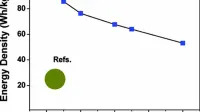Supercapacitor breakthrough beats batteries with graphene *UPDATE

The team, consisting of members from Nanotek Instruments, Angstron Materials and the Dalian University of Technology in China, originally discovered that graphene sheets could be used as a supercapacitor electrode back in 2006. However, the one-atom thick material had a tendency to “restack” itself, which interfered with the necessary ionic fluids (of course!). The researchers have now learned that by using curved graphene sheets instead of the original flat sheets, that problem is avoided and capacitance is greatly improved.
No word yet on when the tech might be commercialized or what further energy density gains might be possible
*UPDATE: We reached out to Bohr Jang of Nanotek Instruments for further information. He speculates commercialization could happen within three years. They also hope to improve the energy density to 100-150 Wh/kg.
[Source: Physics World]




